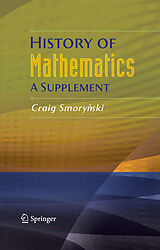History of Mathematics
Einband:
Fester Einband
EAN:
9780387754802
Untertitel:
A Supplement
Autor:
Craig Smorynski
Herausgeber:
Springer New York
Auflage:
2008
Anzahl Seiten:
276
Erscheinungsdatum:
10.12.2007
ISBN:
0387754806
This book offers deeper coverage of key select topics, providing students with material that could encourage more critical thinking. It also includes proofs of important results typically neglected in the modern history of mathematics curriculum.
General textbooks, attempting to cover three thousand or so years of mathematical history, must necessarily oversimplify almost everything, which can scarcely promote a critical approach to the subject. History of Mathematics offers deeper coverage of key select topics, providing students with material that could encourage more critical thinking. It also includes proofs of important results typically neglected in the modern history of mathematics curriculum. Coverage includes: A new approach to the historical development of the natural numbers, which was only settled in the 19th century Construction problems of antiquity, with a proof that the angle cannot be trisected nor the cube duplicated by ruler and compass alone A modern recounting of a Chinese word problem from the 13th century, illustrating the need for consulting multiple sources Lighter material, including historically interesting (and hard to find) poems and humorous song lyrics with mathematical themes.
includes an annotated bibliographys of books on the history of mathematics emphasizes the importance of using primary sources by looking at the distortion of historical facts over time author provides exercises and research projects for students Includes supplementary material: sn.pub/extras
Klappentext
This book attempts to fill two gaps which exist in the standard textbooks on the History of Mathematics. One is to provide students with material that could encourage more critical thinking. General textbooks, attempting to cover three thousand years of mathematical history, must necessarily oversimplify almost everything, the practice of which can scarcely promote a critical approach to the subject. For this reason, Craig Smorynski chooses a more narrow but deeper coverage of a few select topics. The second aim of this book is to include the proofs of important results which are typically neglected in the modern history of mathematics curriculum. The most obvious of these is the oft-cited necessity of introducing complex numbers in applying the algebraic solution of cubic equations. This solution, though it is now relegated to courses in the History of Mathematics, was a major occurrence in the history of mathematics. It was the first substantial piece of mathematics in Europe that was not a mere extension of what the Greeks had done and thus signified the coming of age of European mathematics. The fact that the solution, in the case of three distinct real roots to a cubic, necessarily involved complex numbers both made inevitable the acceptance and study of these numbers and provided a stimulus for the development of numerical approximation methods. Other unique features include: * a prefatory essay on the ways in which sources may be unreliable, followed by an annotated bibliography; * a modern recounting of a Chinese word problem from the 13th century, illustrating the need for consulting multiple sources when the primary source is unavailable; * the solution of the cubic equation, including multiple proofs that the algebraic solution uses complex numbers whenever the cubic equation has three distinct real solutions; * a critical reappraisal of Horner's Method; The final chapter contains lighter material, including a critical look at North Korea's stamps commemorating the 350th birthday of Newton, historically interesting (and hard to find) poems, and drinking songs or limericks with mathematical themes. The appendix outlines a few, small projects which could serve as replacements for the usual term papers. Craig Smorynski is also the author of "Self-Reference and Modal Logic" and "Logical Number Theory I".
Inhalt
Annotated Bibliography.- Foundations of Geometry.- The Construction Problems of Antiquity.- A Chinese Problem.- The Cubic Equation.- Horner's Method.- Some Lighter Material.

Leider konnten wir für diesen Artikel keine Preise ermitteln ...
billigbuch.ch sucht jetzt für Sie die besten Angebote ...
Die aktuellen Verkaufspreise von 6 Onlineshops werden in Realtime abgefragt.
Sie können das gewünschte Produkt anschliessend direkt beim Anbieter Ihrer Wahl bestellen.
Loading...
Die aktuellen Verkaufspreise von 6 Onlineshops werden in Realtime abgefragt.
Sie können das gewünschte Produkt anschliessend direkt beim Anbieter Ihrer Wahl bestellen.
| # | Onlineshop | Preis CHF | Versand CHF | Total CHF | ||
|---|---|---|---|---|---|---|
| 1 | Seller | 0.00 | 0.00 | 0.00 |
